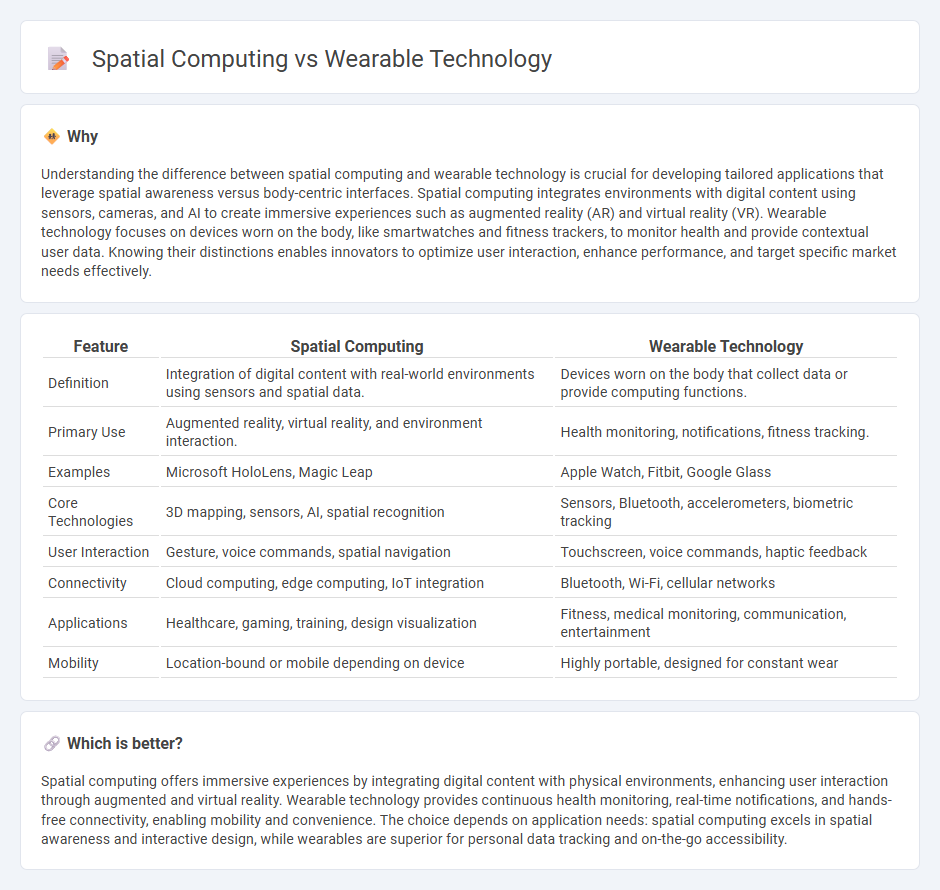
Spatial computing integrates digital and physical environments using technologies like augmented reality (AR), virtual reality (VR), and sensors to create immersive user experiences. Wearable technology, such as smartwatches and fitness trackers, focuses on personal data collection and seamless connectivity for health and convenience. Explore how spatial computing and wearable technology are transforming interaction and data accessibility.
Why it is important
Understanding the difference between spatial computing and wearable technology is crucial for developing tailored applications that leverage spatial awareness versus body-centric interfaces. Spatial computing integrates environments with digital content using sensors, cameras, and AI to create immersive experiences such as augmented reality (AR) and virtual reality (VR). Wearable technology focuses on devices worn on the body, like smartwatches and fitness trackers, to monitor health and provide contextual user data. Knowing their distinctions enables innovators to optimize user interaction, enhance performance, and target specific market needs effectively.
Comparison Table
| Feature | Spatial Computing | Wearable Technology |
|---|---|---|
| Definition | Integration of digital content with real-world environments using sensors and spatial data. | Devices worn on the body that collect data or provide computing functions. |
| Primary Use | Augmented reality, virtual reality, and environment interaction. | Health monitoring, notifications, fitness tracking. |
| Examples | Microsoft HoloLens, Magic Leap | Apple Watch, Fitbit, Google Glass |
| Core Technologies | 3D mapping, sensors, AI, spatial recognition | Sensors, Bluetooth, accelerometers, biometric tracking |
| User Interaction | Gesture, voice commands, spatial navigation | Touchscreen, voice commands, haptic feedback |
| Connectivity | Cloud computing, edge computing, IoT integration | Bluetooth, Wi-Fi, cellular networks |
| Applications | Healthcare, gaming, training, design visualization | Fitness, medical monitoring, communication, entertainment |
| Mobility | Location-bound or mobile depending on device | Highly portable, designed for constant wear |
Which is better?
Spatial computing offers immersive experiences by integrating digital content with physical environments, enhancing user interaction through augmented and virtual reality. Wearable technology provides continuous health monitoring, real-time notifications, and hands-free connectivity, enabling mobility and convenience. The choice depends on application needs: spatial computing excels in spatial awareness and interactive design, while wearables are superior for personal data tracking and on-the-go accessibility.
Connection
Spatial computing integrates digital information with physical environments, enabling advanced interaction through wearable technology such as AR glasses and smartwatches. Wearable devices leverage spatial computing to provide real-time data visualization, immersive augmented reality experiences, and context-aware applications. This synergy enhances user engagement and efficiency in fields like healthcare, gaming, and industrial operations by merging physical and digital realities seamlessly.
Key Terms
Sensors
Wearable technology primarily integrates biosensors such as accelerometers, gyroscopes, heart rate monitors, and temperature sensors to track physiological data and movement in real time. Spatial computing employs advanced depth sensors, LiDAR, cameras, and environmental scanners to create immersive augmented reality (AR) and virtual reality (VR) experiences by mapping and interacting with physical spaces. Explore the latest innovations in sensor technology driving the convergence of wearables and spatial computing for enhanced user interaction.
Augmented Reality (AR)
Wearable technology integrates devices like smart glasses and AR headsets, enabling hands-free access to Augmented Reality (AR) that overlays digital information onto the physical world. Spatial computing advances AR by mapping and interacting with the user's environment in real-time, enhancing immersive experiences through precise spatial awareness and contextual data. Explore the latest innovations in AR to understand how these technologies are transforming user interaction and connectivity.
Human-Computer Interaction
Wearable technology enhances Human-Computer Interaction (HCI) by enabling seamless, real-time data exchange through devices like smartwatches, fitness trackers, and AR glasses, offering personalized user experiences. Spatial computing integrates digital and physical environments using sensors, 3D mapping, and gesture recognition to create immersive interactions with augmented reality (AR) and virtual reality (VR) applications. Explore more about how these cutting-edge technologies redefine connectivity and interface design in the digital landscape.
Source and External Links
Wikipedia - Wearable technology - Wearable technology refers to electronic devices designed to be worn on the body, such as smartwatches, fitness trackers, and smart glasses, which collect data on health, activity, and environment.
TechTarget - What is Wearable Technology? Definition, Uses and Examples - Wearable technology includes a diverse range of devices--from smart jewelry and medical patches to advanced VR headsets--that use sensors and connectivity to track user data in real time.
Built In - What Is Wearable Technology? Examples of Wearables in Fashion - Wearables are increasingly integrated into fashion, with smart clothing and accessories that monitor movement, regulate temperature, or even harvest energy, blending technology seamlessly into everyday apparel.
 dowidth.com
dowidth.com